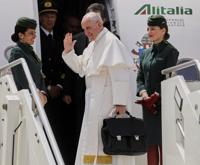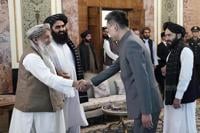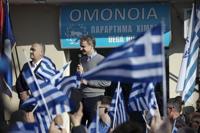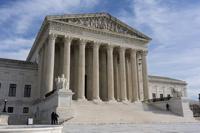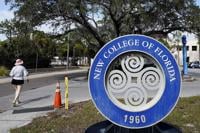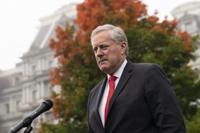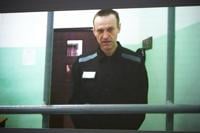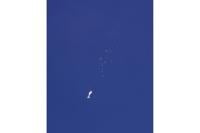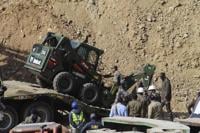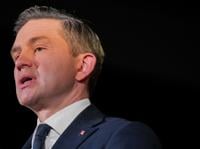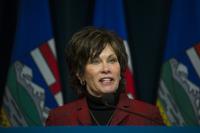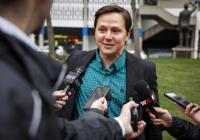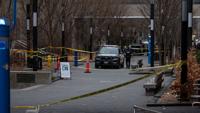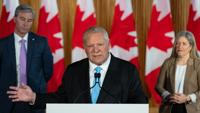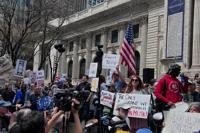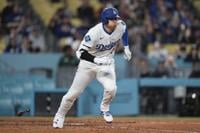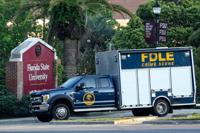VATICAN CITY (AP) — During his first foreign trip in 2013, Pope Francis made headlines when he carried his own black leather briefcase as he boarded the Alitalia charter bound for Brazil, since popes never carry bags and until the 1970s were themselves carried on thrones.
Asked what was in the bag, Francis joked that it wasn’t the nuclear codes. But he seemed baffled that something as normal as an airplane passenger carrying a briefcase could create such a fuss.
“I have always taken a bag with me when traveling – it’s normal,” he told as pope. “We must get used to being normal. The normality of life.”
Over 12 years, Francis has sought to impose a kind of normality on the papacy with his informal style and disdain for pomp, while ensuring that he still wields the awesome power held by Christ’s vicar on Earth and .
The way Francis has managed his for pneumonia has followed that same playbook, and on Saturday allowed his doctors to announce the very normal news that the 88-year-old pope would be released the following day.
At a news conference, they said he would need two months of rest and convalescence at the Vatican, but that he eventually could resume all his normal activity running the 1.3.-billion strong Catholic Church.
Francis has stayed in control, remotely
But he had never stopped. In between respiratory crises, prayer and physiotherapy, Francis appointed over a dozen bishops, approved a handful of new saints, authorized a three-year extension of his and sent off messages public and private. Vatican cardinals at events requiring his presence.
That’s not as easy a balancing act as it sounds, since there are few positions of power that are both as and, during times of illness, as seemingly fragile: According to the church's canon law, the pope possesses “supreme, full, immediate, and universal ordinary power in the church." He answers to no one but God, and there is no appeal of his decisions.
And while popes aren’t subject to re-election campaigns or no-confidence votes, they essentially owe their jobs to the 120 men who elected them. While those same cardinals swear obedience to the pope, they will also eventually choose his successor from within their own ranks. It's no surprise then that papal contenders and challenges facing a future pope has been a constant buzz in Rome ever since Francis was admitted to Gemelli hospital Feb. 14.
Francis is well aware that anytime he gets sick, plotting intensifies for the election of the next pope, contributing to a certain lame duck status as he ages. “Some wanted me dead,” he said after his 2021 hospitalization, when he learned that secret meetings had already been held to plan the conclave. He knows as well that even before his current hospitalization, an anonymous cardinal had circulated a seven-point memo listing priorities for the next pope to correct the “confusion, division and conflict” sowed by Francis.
But he's not shy about showing weakness
And yet Francis has never been shy about , age or infirmities in ways that seem unthinkable for public figures for whom any sign of fragility can threaten their authority and undermine their agenda.
Additionally, within months of being elected, Francis reached out to an Argentine doctor and journalist, Dr. Nelson Castro, and suggested he write a book about the health of popes, himself included.
“My hypothesis is that he wanted first of all to show himself as a human being,” Castro said in an interview. “We tend to see popes like saints, but the way he talked about his diseases showed me, ‘I’m like you and me, being exposed to diseases.’”
Francis had read and appreciated Castro’s earlier book, “The Sickness of Power,” about the ailments that have afflicted Argentina’s leaders and how power itself had afflicted them. He invited Castro to research and write about past popes and his own case in a similar, not-terribly-flattering light.
“The Health of Popes” was published in 2021. Castro said what struck him most was that Francis disclosed not only his physical ailments, but his mental health challenges too: Francis revealed that he had gone to a psychiatrist when he was the Jesuit provincial during Argentina’s military dictatorship in the 1970s to help him cope with fear and anxiety.
“Pope Francis is a man of power,” Castro said. “Only a man of power, feeling quite sure of himself, would dare to talk about his diseases so openly.”
The balance of strength in weakness is very Jesuit
For the Rev. John Cecero, Jesuit provincial for the northeast United States from 2014-2020, Francis’ willingness to show his weaknesses while exercising supreme authority is consistent with his Jesuit training and the biblical teaching of St. Paul that “when I am weak, then I am strong.”
“A chief virtue on the part of everyone in the practice of Jesuit authority is humility," Cecero said in an interview. "On the part of the individual Jesuit (that means) thinking beyond my own self-interest to the common good.”
“I know it’s something that drives Francis: that you have that same humility,” he said.
And yet Francis’ critics often complain that he’s authoritarian, that he takes decisions in a vacuum and without regard to the law, and wields power like a the title of a book written by a traditionalist critic early in Francis’ papacy.
Many recite the joke about the way Jesuit superiors exercise power, which is supposed to be a process of joint discernment between the superior and the underling but, the joke goes, can be anything but: “I discern, you discern, we discern … I decide.”
Those same conservative critics, of course, have been keenly watching Francis’ hospitalization and wondering if the end of his papacy is near.
Even if he is absent, and even if he has to cut back his public activities going forward, Francis is very much still in power and leading the church, said Kurt Martens, a canon lawyer at Catholic University of America.
“We’re used to seeing a pope who is everywhere all the time," he said. "But don't forget that in the past, not that long ago, popes would show up only rarely.”
He may be absent, but he's still in control
Francis' disappearance from public view has led some to doubt the authenticity of the first, and so far released by the Vatican since his hospitalization. It was shot from behind and showed Francis at prayer in his private hospital chapel, his face hidden.
Avvenire, the newspaper of the Italian bishops’ conference, said the photo was not only real but showed Francis controlling the image that he wants the faithful to have of the papacy and illness. Francis wants viewers to focus not on the spectacle of a sick pope, but on what should actually matter more to a Catholic anyway.
“If we cannot see his face ... what we must look at is precisely what he himself is facing: the altar and the crucifix,” Avvenire wrote.
___
Associated Press religion coverage receives support through the AP’s with The Conversation US, with funding from Lilly Endowment Inc. The AP is solely responsible for this content.


